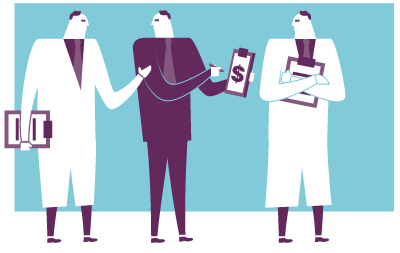
Data from clinical trials are important in approving new medicines and discovering new treatments. But Big Pharma funds and runs most clinical trials. According to critics, this could allow drug companies to fake study results or hide dangerous side effects to get their drug approved or increase sales.



Editors carefully fact-check all Drugwatch.com content for accuracy and quality.
Drugwatch.com has a stringent fact-checking process. It starts with our strict sourcing guidelines.
We only gather information from credible sources. This includes peer-reviewed medical journals, reputable media outlets, government reports, court records and interviews with qualified experts.
Before the U.S. Food and Drug Administration (FDA) approves a prescription drug, it must first go through a series of clinical trials. Data obtained from these trials should ensure the safety and effectiveness of drugs before they make it into the hands of patients.

Each year, the National Institutes of Health’s (NIH) budget provides less money to fund clinical trials. Because of this, Big Pharma pays for and runs the majority of these trials.
It then provides data to the FDA for drug approvals and safety reviews after the drug hits the market. While this practice may help get more drugs approved and allow more treatments to reach patients sooner, it may also lead to unknown risks.
According to critics and consumer watchdogs in 2022, Big Pharma’s influence over clinical trials could allow drug companies to focus on the benefits of a drug and downplay the risks for the sake of profit. This biased information could also influence doctors to prescribe a drug without knowing all the risks.
How Big Pharma Influences Trial Results
It can cost billions to develop a new drug, and drug manufacturers want a return on their investment. For example, studies indicated that cost estimates of bringing a new drug to the market can start at approximately $160 million and end up as high as $2 billion.

Brand-name drugs that are still under patent make the most money for drug companies. In addition, only about 34 percent of these trials make it to the final phase to testing, according to a 2014 study by Michael Hay and colleagues published in Nature Biotechnology. This puts more pressure on drug companies to have successful clinical trials.
To this end, Big Pharma may influence clinical trials in a number of ways, including funding the trials, designing the trials and handpicking trial results. These practices could skew trial results in favor of drug companies and put patients at risk.
“Clinical trials for pharmaceuticals are conducted and funded by the industry.”
For example, the New England Journal of Medicine — one of the most prestigious medical journals in the world — published 73 studies of new drugs. Of those studies, a pharmaceutical company funded 60, 50 had drug-company employees among the authors and 37 lead researchers had accepted money from a drug company, according to a review conducted by the Washington Post.
This means drug companies greatly influence the majority of medical information provided to the public.
Unreliable clinical trials resulting from the possibility for bias due to Big Pharma influence is an ongoing issue because “clinical trials for pharmaceuticals are conducted and funded by the industry,” Dr. Michael A. Carome, director of the Health Research Group of Public Citizens in Washington, D.C., told Drugwatch.
Funding
The most apparent way in which a drug company can influence a clinical trial is by providing the funding. Clinical trials can be expensive. For example, new medicines that treat illnesses affecting the respiratory system are the most expensive trials to run and average about $115.3 million.
Because of the high price tag and because most trials are for new drugs, Big Pharma often funds the trials. In 2012, pharmaceutical companies paid $39 billion for trials, while NIH paid $31 billion.
Studies funded by the NIH, academic medical centers or voluntary specialty groups (charities) are classified as independent studies because these groups are not driven by money to achieve a successful outcome. These types of trials are the gold standard for data and more likely to be in the best interest of the patient.

But data shows each year there are fewer independent studies.
For instance, a report from John Hopkins University showed that the number of clinical trials funded by the pharmaceutical industry has increased each year since 2006, while those funded by the NIH decreased. In 2014, Big Pharma paid for 6,550 trials, while NIH funded 1,048, according to a study by Stephan Ehrhardt and colleagues published in JAMA.
“That’s important for the general public, I think, because if we only get industry funded trials off the ground and given that the industry has a vested interest in the outcome of those trials then we don’t get good data to inform health of the public,” Ehrhardt told Reuters Health about the study results.
| Therapeutic Area | Phase 1 | Phase 2 | Phase 3 | FDA NDA/ BLA Revew Phase [C] | Phase 4 | Total |
|---|---|---|---|---|---|---|
| Respiratory System | $5.2 | $12.2 | $23.1 | $2.0 | $72.9 | $115.3 |
| Pain and Anesthesia | $1.4 | $17.0 | $52.9 | $2.0 | $32.1 | $105.4 |
| Oncology | $4.5 | $11.2 | $22.1 | $2.0 | $38.9 | $78.6 |
| Opthlmology | $5.3 | $13.8 | $30.7 | $2.0 | $17.6 | $69.4 |
| Hematology | $1.7 | $19.6 | $15.0 | $2.0 | $27.0 | $65.2 |
| Cardiovascular | $2.2 | $7.0 | $25.2 | $2.0 | $27.8 | $65.2 |
| Endocrine | $1.4 | $12.1 | $17.0 | $2.0 | $26.7 | $59.1 |
| Gastrointestinal | $2.4 | $15.8 | $14.5 | $2.0 | $21.8 | $56.4 |
| Immunomodulation | $6.6 | $16.0 | $11.9 | $2.0 | $19.8 | $56.2 |
| Anti-Infective | $4.2 | $14.2 | $22.8 | $2.0 | $11.0 | $54.2 |
| Central Nervous System | $3.9 | $13.9 | $19.2 | $2.0 | $14.1 | $53.1 |
| Dermatology | $1.8 | $8.9 | $11.5 | $2.0 | $25.2 | $49.3 |
Trial Design
While pharmaceutical companies may conduct clinical trials for any number of the reasons, the primary reason is to test the safety and effectiveness of a new drug and device for FDA approval. The FDA has a list of guidelines for properly conducting clinical trials.

But drug companies’ primary motivation is “big profits.” So, they design studies and report the results “in a manner that is biased toward showing a favorable risk-benefit profile,” Carome told Drugwatch.
It is not unusual for clinical trials to be run, designed and analyzed by researchers on the drug company’s payroll. For example, it’s common practice for drug companies to hire private physicians or third-party companies called contract research organizations (CROs) to run trials for them.
The problem is many of these doctors and CROs are more focused on profit than research.
In a 2012 study published in PLoS Medicine, bioethicist Jill A. Fisher of Vanderbilt University and doctoral student Corey A. Kalbaugh of University of North Carolina Chapel Hill interviewed and observed physicians and research staff at 25 private-sector research organizations in the U.S.
They found money was the primary reason these doctors became contract researchers — some said they earned around $300,000 a year as principal investigators (PI). PIs are important because they are supposed to be highly qualified doctors who supervise the trials and analyze the final results.
But PIs interviewed by Fisher and Kalbaugh said they viewed themselves more as businessmen and not researchers. As a result, their ethics were more aligned with industry goals. Many PIs hired other staff to do their work for them and very few actually participated in writing the final study.
“Several study coordinators in our sample joked about how clinical research helped physicians improve their golf games,” Fisher and Kalbaugh wrote in their study. “Our observations confirm that at the majority of the 25 sites at which we conducted our research, the PIs were frequently absent from the clinic.”
“I mean, if somebody says we have this really great drug that works for blood pressure, I have no idea how this damn thing works! But I’m still going to go down the hall and do physicals and check blood pressures and sign off adverse events,” one PI in the study said.
These practices may lead to mistakes or poorly run trials.
In the case of Essure Permanent Birth Control, a number of trial participants came forward stating that Conceptus falsified questionnaire answers and omitted side effects in its report to the FDA. As a result, the FDA is investigating these claims.
Because it is in the drug company’s best interest to publish positive results about their drugs, researchers rarely publish studies with negative results. This practice is also referred to as publication bias.
Carome, the director of Public Citizen, stated that publication bias is a “significant problem.” Carome said that “the decision to publish the results of a study on a particular drug lies entirely with the study’s investigators, including pharmaceutical companies who conduct and fund clinical trials testing their drug products. The medical literature is thus a partial, and often biased, sample of all medical evidence.”
Carome used an example from a 2008 study of antidepressant drug trials submitted to the FDA, noting that the pharmaceutical companies that developed these drugs published 97 percent of the trials that yielded positive results. Only 39 percent of the studies that were found to have “negative” or “questionable” results as determined by the FDA were published.
For example, in 2014, the Cochrane Collaboration — a nonprofit, independent organization — published its safety and effectiveness findings on the popular anti-flu drug Tamiflu. The drug’s manufacturer, Roche, marketed the drug as an effective way to fight the flu.
Cochrane uncovered more than 70 clinical trials and more than 100,000 pages of unpublished data — many of them were negative or inconclusive trial results. It found the drug had little to no benefit in preventing the flu or shortening the duration of flu symptoms. It also had a chance of life-threatening side effects, including suicide linked to the drug.
Neither the FDA nor the European Medicines Association (EMA) recorded any of the suicides linked to Tamiflu during trials.

What Happens When Big Pharma Influences Trial Results?
If Big Pharma influences trial results, it makes data on drugs unreliable. The biggest problem with unreliable data is that doctors don’t have the proper information to make good decisions for their patients, and patients may be forced to question the safety of their medications.
A drug that starts out as a miracle cure may later turn out to be dangerous and life-threatening. There are several examples of drugs with manipulated data or poorly designed clinical trials that later ended up hurting people.
- Avandia
- GlaxoSmithKline widely publicized positive trial data about the effectiveness of its Type 2 diabetes medication Avandia. But hidden clinical trial data warned that the drug could increase the risk of heart attacks. This fact was buried.
- Vioxx
- Like GlaxoSmithKline, Merck published positive clinical trial results for its painkiller Vioxx. It marketed the drug heavily and the drug became a blockbuster.
- Seroquel
- One of the most tragic examples of what can happen when clinical trials are poorly run and driven by profit is the story of AstraZeneca’s antipsychotic Seroquel and Dan Markingson. AstraZeneca hired Dr. S. Charles Schulz to run a clinical trial focused on proving the drug could treat schizophrenia. In 2003, 26-year- Markingson joined the clinical trial and six months later committed suicide by nearly decapitating himself with a box cutter. The death sparked an investigation. It found that Schulz and Markingson’s doctor, Stephen Olson, had received hundreds of thousands of dollars from drug companies, including AstraZeneca, Time magazine reported in 2011. As far back as 2000, Schulz manipulated data to make Seroquel seem better than other medications on the market.
- INFUSE Bone Graft and DePuy ASR Hip Implants
- Medical-device makers may also obscure clinical trial and study results. For instance, in 2011 Dr. Eugene J. Carragee accused Medtronic of hiding side-effect data for its Infuse Bone Graft. Carragee and several colleagues published an editorial in The Spine Journal showing Medtronic-sponsored studies did not disclose possible life-threatening side effects associated with rhBMP-2 — the active component of Infuse. Carragee and colleagues wrote that side effects were “perhaps 10 to 50 times the original estimates calculated from industry-sponsored studies.” In litigation over Johnson & Johnson’s DePuy ASR hip implant, legal documents revealed that studies conducted by DePuy found the early failure rate of its hip implant was as high as 40 percent. But in publicly available studies, the rate was about 13 percent. Thousands of people with DePuy hips suffered crippling injuries when the implants failed early and caused metal poisoning. They later filed lawsuits and DePuy settled for about $4 billion.

What Can Be Done?
Big Pharma has been influencing medicine for decades, but there are a few ways in which people might be able to protect themselves. Some of these include research, searching for a history of lawsuits, changing laws and being wary of newer drugs.
- Research a Drug or Device
- The first way people can protect themselves is to be informed. Patients must work with their doctors to get the whole story about a prescription drug or medical device. Fortunately, the internet can make research easier. Many studies on drugs are made public. Before taking a drug or receiving a device, people can read up on the possible risks and benefits and discuss them with their doctor. Through the Freedom of Information Act (FOIA), any person has the right to request records from a federal agency, though there are some exceptions. Patients can request medical studies on any drug reviewed by the FDA through FOIA.
- History of Lawsuits
- If a drug or device a patient may be taking has a history of lawsuits, it’s a red flag. Typically, these lawsuits can involve thousands of people, such as the case with Avandia and Vioxx. People affected by dangerous drugs and devices may also choose to file a lawsuit of their own against drug companies.
- Legislation
- One reason drug companies have so much influence on clinical trials is that they run and pay for many of them. Increasing the NIH budget for clinical trials may help ensure more trials remain independent. People can contact their district Congressional representatives and encourage them to take these concerns to Washington. They can also encourage more transparency in clinical trials and for stricter guidelines and rules.
- New Drugs Are Not Always Better
- Carome, the Public Citizen director, said patients can protect themselves by following Public Citizen’s Health Research Group’s 7-year rule: “Unless a new drug represents a true breakthrough treatment, avoid using it until seven years after approval.” According to Carome, after that 7-year period, enough additional data regarding the safety and effectiveness of the drug or device has usually been accumulated to establish that the treatment’s benefits will hopefully outweigh the risks.
Calling this number connects you with a Drugwatch.com representative. We will direct you to one of our trusted legal partners for a free case review.
Drugwatch.com's trusted legal partners support the organization's mission to keep people safe from dangerous drugs and medical devices. For more information, visit our partners page.